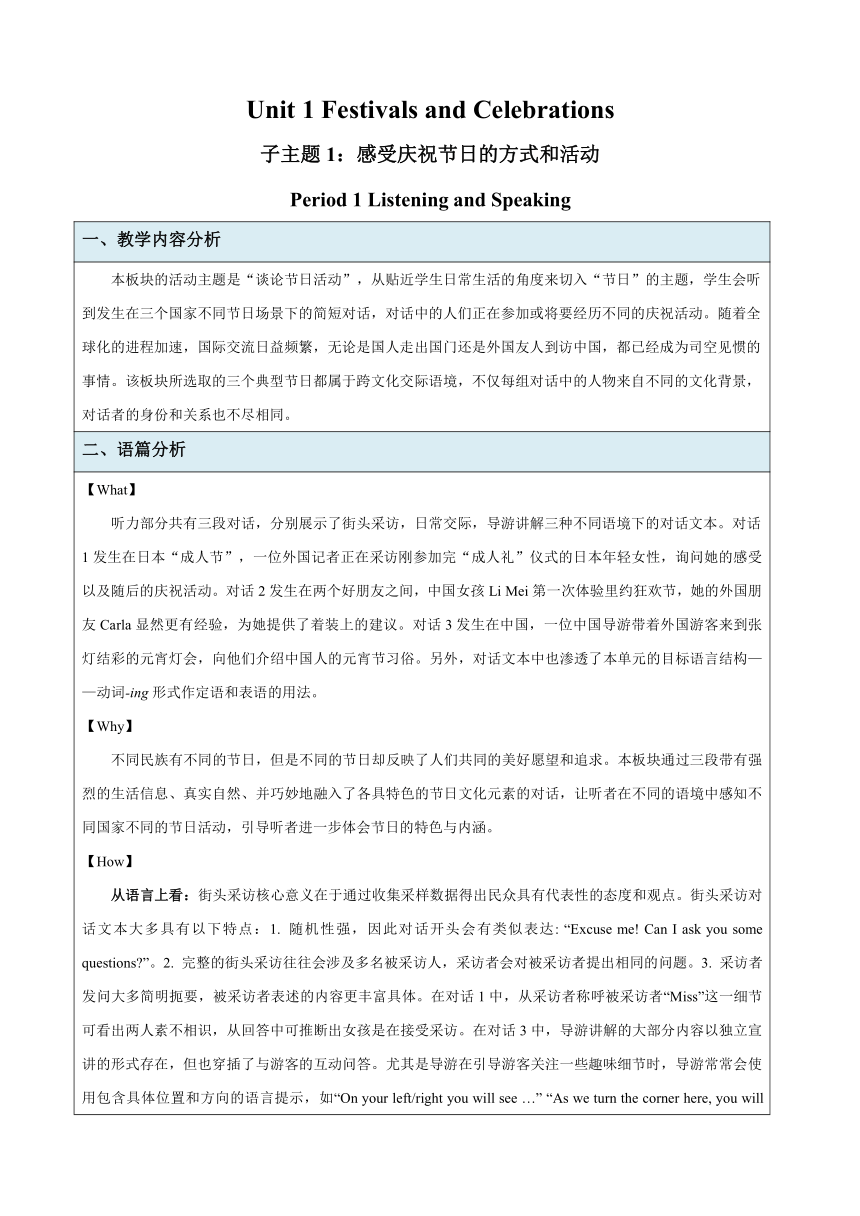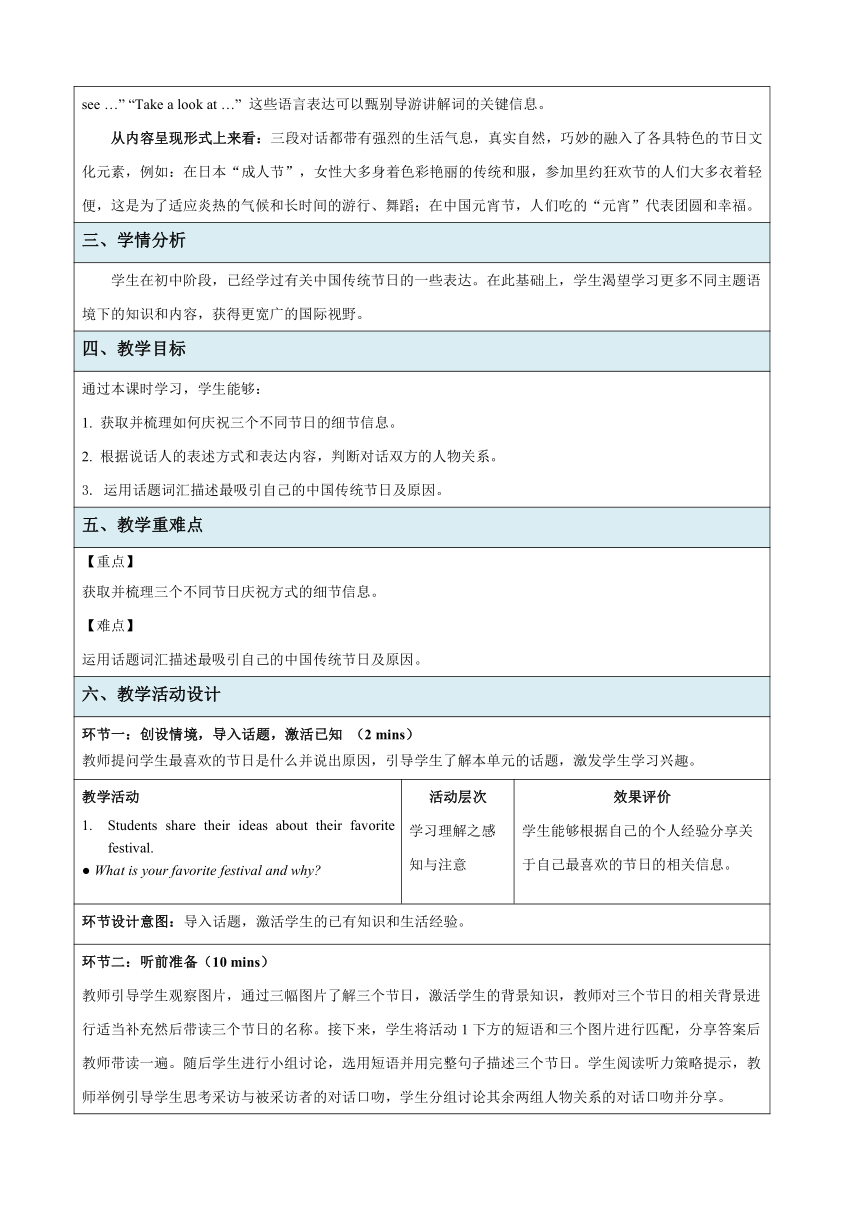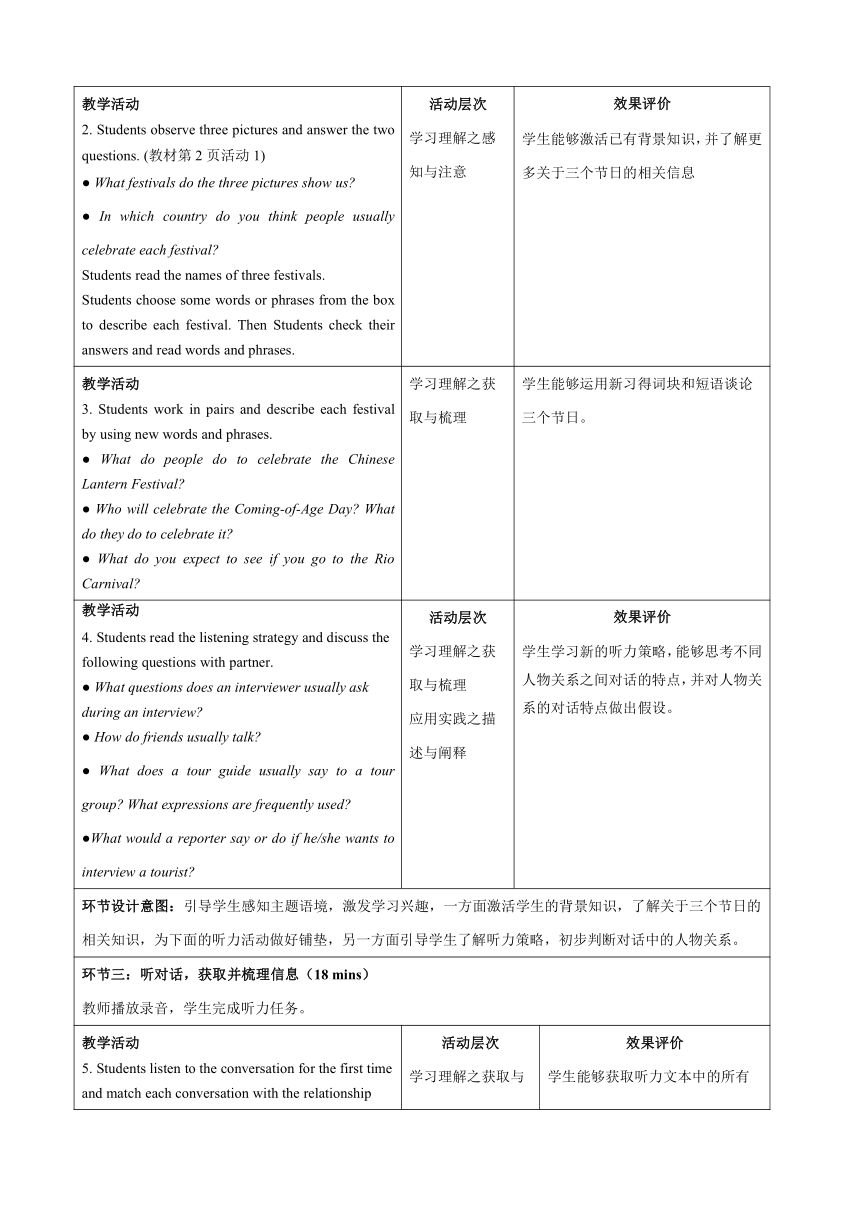人教版(2019)必修第三册Unit 1 Festivals and Celebrations Listening and Speaking教学设计(表格式)
文档属性
| 名称 | 人教版(2019)必修第三册Unit 1 Festivals and Celebrations Listening and Speaking教学设计(表格式) |  | |
| 格式 | docx | ||
| 文件大小 | 22.3KB | ||
| 资源类型 | 教案 | ||
| 版本资源 | 人教版(2019) | ||
| 科目 | 英语 | ||
| 更新时间 | 2024-05-05 21:24:16 | ||
图片预览



文档简介
Unit 1 Festivals and Celebrations
子主题1:感受庆祝节日的方式和活动
Period 1 Listening and Speaking
一、教学内容分析
本板块的活动主题是“谈论节日活动”,从贴近学生日常生活的角度来切入“节日”的主题,学生会听到发生在三个国家不同节日场景下的简短对话,对话中的人们正在参加或将要经历不同的庆祝活动。随着全球化的进程加速,国际交流日益频繁,无论是国人走出国门还是外国友人到访中国,都已经成为司空见惯的事情。该板块所选取的三个典型节日都属于跨文化交际语境,不仅每组对话中的人物来自不同的文化背景,对话者的身份和关系也不尽相同。
二、语篇分析
【What】 听力部分共有三段对话,分别展示了街头采访,日常交际,导游讲解三种不同语境下的对话文本。对话1发生在日本“成人节”,一位外国记者正在采访刚参加完“成人礼”仪式的日本年轻女性,询问她的感受以及随后的庆祝活动。对话2发生在两个好朋友之间,中国女孩Li Mei第一次体验里约狂欢节,她的外国朋友Carla显然更有经验,为她提供了着装上的建议。对话3发生在中国,一位中国导游带着外国游客来到张灯结彩的元宵灯会,向他们介绍中国人的元宵节习俗。另外,对话文本中也渗透了本单元的目标语言结构——动词-ing形式作定语和表语的用法。 【Why】 不同民族有不同的节日,但是不同的节日却反映了人们共同的美好愿望和追求。本板块通过三段带有强烈的生活信息、真实自然、并巧妙地融入了各具特色的节日文化元素的对话,让听者在不同的语境中感知不同国家不同的节日活动,引导听者进一步体会节日的特色与内涵。 【How】 从语言上看:街头采访核心意义在于通过收集采样数据得出民众具有代表性的态度和观点。街头采访对话文本大多具有以下特点:1. 随机性强,因此对话开头会有类似表达: “Excuse me! Can I ask you some questions ”。2. 完整的街头采访往往会涉及多名被采访人,采访者会对被采访者提出相同的问题。3. 采访者发问大多简明扼要,被采访者表述的内容更丰富具体。在对话1中,从采访者称呼被采访者“Miss”这一细节可看出两人素不相识,从回答中可推断出女孩是在接受采访。在对话3中,导游讲解的大部分内容以独立宣讲的形式存在,但也穿插了与游客的互动问答。尤其是导游在引导游客关注一些趣味细节时,导游常常会使用包含具体位置和方向的语言提示,如“On your left/right you will see …” “As we turn the corner here, you will see …” “Take a look at …” 这些语言表达可以甄别导游讲解词的关键信息。 从内容呈现形式上来看:三段对话都带有强烈的生活气息,真实自然,巧妙的融入了各具特色的节日文化元素,例如:在日本“成人节”,女性大多身着色彩艳丽的传统和服,参加里约狂欢节的人们大多衣着轻便,这是为了适应炎热的气候和长时间的游行、舞蹈;在中国元宵节,人们吃的“元宵”代表团圆和幸福。
三、学情分析
学生在初中阶段,已经学过有关中国传统节日的一些表达。在此基础上,学生渴望学习更多不同主题语境下的知识和内容,获得更宽广的国际视野。
四、教学目标
通过本课时学习,学生能够: 1. 获取并梳理如何庆祝三个不同节日的细节信息。 2. 根据说话人的表述方式和表达内容,判断对话双方的人物关系。 3. 运用话题词汇描述最吸引自己的中国传统节日及原因。
五、教学重难点
【重点】 获取并梳理三个不同节日庆祝方式的细节信息。 【难点】 运用话题词汇描述最吸引自己的中国传统节日及原因。
六、教学活动设计
环节一:创设情境,导入话题,激活已知 (2 mins) 教师提问学生最喜欢的节日是什么并说出原因,引导学生了解本单元的话题,激发学生学习兴趣。
教学活动 Students share their ideas about their favorite festival. ● What is your favorite festival and why 活动层次 学习理解之感知与注意 效果评价 学生能够根据自己的个人经验分享关于自己最喜欢的节日的相关信息。
环节设计意图:导入话题,激活学生的已有知识和生活经验。
环节二:听前准备(10 mins) 教师引导学生观察图片,通过三幅图片了解三个节日,激活学生的背景知识,教师对三个节日的相关背景进行适当补充然后带读三个节日的名称。接下来,学生将活动1下方的短语和三个图片进行匹配,分享答案后教师带读一遍。随后学生进行小组讨论,选用短语并用完整句子描述三个节日。学生阅读听力策略提示,教师举例引导学生思考采访与被采访者的对话口吻,学生分组讨论其余两组人物关系的对话口吻并分享。
教学活动 2. Students observe three pictures and answer the two questions. (教材第2页活动1) ● What festivals do the three pictures show us ● In which country do you think people usually celebrate each festival Students read the names of three festivals. Students choose some words or phrases from the box to describe each festival. Then Students check their answers and read words and phrases. 活动层次 学习理解之感知与注意 效果评价 学生能够激活已有背景知识,并了解更多关于三个节日的相关信息
教学活动 3. Students work in pairs and describe each festival by using new words and phrases. ● What do people do to celebrate the Chinese Lantern Festival ● Who will celebrate the Coming-of-Age Day What do they do to celebrate it ● What do you expect to see if you go to the Rio Carnival 学习理解之获取与梳理 学生能够运用新习得词块和短语谈论三个节日。
教学活动 4. Students read the listening strategy and discuss the following questions with partner. ● What questions does an interviewer usually ask during an interview ● How do friends usually talk ● What does a tour guide usually say to a tour group What expressions are frequently used ●What would a reporter say or do if he/she wants to interview a tourist 活动层次 学习理解之获取与梳理 应用实践之描述与阐释 效果评价 学生学习新的听力策略,能够思考不同人物关系之间对话的特点,并对人物关系的对话特点做出假设。
环节设计意图:引导学生感知主题语境,激发学习兴趣,一方面激活学生的背景知识,了解关于三个节日的相关知识,为下面的听力活动做好铺垫,另一方面引导学生了解听力策略,初步判断对话中的人物关系。
环节三:听对话,获取并梳理信息(18 mins) 教师播放录音,学生完成听力任务。
教学活动 5. Students listen to the conversation for the first time and match each conversation with the relationship between the speakers and check their answers. (教材第2页活动2) Next, Students listen to the conversation for the second time and complete sentences with the correct words and share with whole class. (教材第3页活动3) Then Students listen to the conversation again and make a list of each festival’s activities and share with whole class. (教材第3页活动4) 活动层次 学习理解之获取与梳理 应用实践之描述与阐释 效果评价 学生能够获取听力文本中的所有细节信息并分享。之后呈现出三段听力材料文本,引导学生观察并总结对话的核心内容。
环节设计意图:引导学生关注并学习听力策略:判断人物关系,并运用于语言情境中。引导学生关注听力文本的大意及细节,为后续学生的知识迁移及创造性表达提供语言基础。
环节四:联系自身经验,所学新知,介绍自己喜欢的节日 (10 mins) 教师引导学生思考自己最喜欢的中国传统节日是什么以及原因,并写下关键词块,随后学生进行小组讨论完成一组对话,互相介绍最吸引自己的中国传统节日以及原因。
教学活动 6. Students consider the question and take down key words. ● Which Chinese traditional festival attracts you most and why 活动层次 应用实践之内化与运用 效果评价 学生能够联系自身的生活经验以及本节课所学新知,描述自己最喜欢的中国传统节日及原因。
7. Students work in pairs and introduce their favorite traditional Chinese festival and then share with the whole class. 活动层次 迁移创新之想象与创造 效果评价 学生能够通过语言表达出自己喜欢的中国传统节日并了解其他同学的喜好。
环节设计意图:引导学生通过谈论自己最喜欢的中国传统节日,内化新知,实现知识、能力和情感态度的迁移。
作业与拓展学习设计 1. Think about more expressions that can help to distinguish the relationship between speakers. 2. Find information about a foreign festival you are interested in.
Worksheet
Period 1 Listening and Speaking
Activity 1: Think and share
●What is your favorite festival and why
My favorite festival is … because …
I like … best because …
Activity 2: Look and answer
Look at the pictures on page 2 and answer the two questions
●What festivals do the three pictures show us
●In which country do you think people usually celebrate each festival
Choose some words or phrases from the box to describe each festival. (教材第2页活动1)
Activity 3: Describe each festival
Please describe the three festivals by using the words or phrases from the box.
●What do people do to celebrate the Chinese Lantern Festival
●Who will celebrate the Coming-of-Age Day What do they do to celebrate it
●What do you expect to see if you go to the Rio Carnival
Activity 4: Read and think
Please read the listening strategy and discuss the following questions with your partner.
●What questions does an interviewer usually ask during an interview
●How do friends usually talk
●What does a tour guide usually say to a tour group What expressions are frequently used
●What would a reporter say or do if he/she wants to interview a tourist
Activity 5: Listen and finish activities
I. Listen to the conversation and match each conversation with the relationship between the speakers.
II. Listen again and complete the sentences with the correct words.
III. Listen again and make a list of each festival’s activities.
IV. Pay attention to what people talk about in the conversation 1-3.
Activity 6: Brainstorm
●Which Chinese traditional festival attracts you most and why
Personally, ... attracts me most because ...
Activity 7: Make an introduction
Work in pairs and introduce your favorite Chinese traditional festival.
Item Peer-evaluation Teacher-evaluation
Contents about the Chinese traditional festival: Date/Special activities/Traditional food… ☆ ☆ ☆ ☆ ☆ ☆ ☆ ☆ ☆ ☆
Language accuracy: Pronunciation/ Vocabulary/Grammar
Fluency
Logic and coherence
Homework:
1. Think about more expressions that can help to distinguish the relationship between speakers.
2. Find information about a foreign festival you are interested in.
子主题1:感受庆祝节日的方式和活动
Period 1 Listening and Speaking
一、教学内容分析
本板块的活动主题是“谈论节日活动”,从贴近学生日常生活的角度来切入“节日”的主题,学生会听到发生在三个国家不同节日场景下的简短对话,对话中的人们正在参加或将要经历不同的庆祝活动。随着全球化的进程加速,国际交流日益频繁,无论是国人走出国门还是外国友人到访中国,都已经成为司空见惯的事情。该板块所选取的三个典型节日都属于跨文化交际语境,不仅每组对话中的人物来自不同的文化背景,对话者的身份和关系也不尽相同。
二、语篇分析
【What】 听力部分共有三段对话,分别展示了街头采访,日常交际,导游讲解三种不同语境下的对话文本。对话1发生在日本“成人节”,一位外国记者正在采访刚参加完“成人礼”仪式的日本年轻女性,询问她的感受以及随后的庆祝活动。对话2发生在两个好朋友之间,中国女孩Li Mei第一次体验里约狂欢节,她的外国朋友Carla显然更有经验,为她提供了着装上的建议。对话3发生在中国,一位中国导游带着外国游客来到张灯结彩的元宵灯会,向他们介绍中国人的元宵节习俗。另外,对话文本中也渗透了本单元的目标语言结构——动词-ing形式作定语和表语的用法。 【Why】 不同民族有不同的节日,但是不同的节日却反映了人们共同的美好愿望和追求。本板块通过三段带有强烈的生活信息、真实自然、并巧妙地融入了各具特色的节日文化元素的对话,让听者在不同的语境中感知不同国家不同的节日活动,引导听者进一步体会节日的特色与内涵。 【How】 从语言上看:街头采访核心意义在于通过收集采样数据得出民众具有代表性的态度和观点。街头采访对话文本大多具有以下特点:1. 随机性强,因此对话开头会有类似表达: “Excuse me! Can I ask you some questions ”。2. 完整的街头采访往往会涉及多名被采访人,采访者会对被采访者提出相同的问题。3. 采访者发问大多简明扼要,被采访者表述的内容更丰富具体。在对话1中,从采访者称呼被采访者“Miss”这一细节可看出两人素不相识,从回答中可推断出女孩是在接受采访。在对话3中,导游讲解的大部分内容以独立宣讲的形式存在,但也穿插了与游客的互动问答。尤其是导游在引导游客关注一些趣味细节时,导游常常会使用包含具体位置和方向的语言提示,如“On your left/right you will see …” “As we turn the corner here, you will see …” “Take a look at …” 这些语言表达可以甄别导游讲解词的关键信息。 从内容呈现形式上来看:三段对话都带有强烈的生活气息,真实自然,巧妙的融入了各具特色的节日文化元素,例如:在日本“成人节”,女性大多身着色彩艳丽的传统和服,参加里约狂欢节的人们大多衣着轻便,这是为了适应炎热的气候和长时间的游行、舞蹈;在中国元宵节,人们吃的“元宵”代表团圆和幸福。
三、学情分析
学生在初中阶段,已经学过有关中国传统节日的一些表达。在此基础上,学生渴望学习更多不同主题语境下的知识和内容,获得更宽广的国际视野。
四、教学目标
通过本课时学习,学生能够: 1. 获取并梳理如何庆祝三个不同节日的细节信息。 2. 根据说话人的表述方式和表达内容,判断对话双方的人物关系。 3. 运用话题词汇描述最吸引自己的中国传统节日及原因。
五、教学重难点
【重点】 获取并梳理三个不同节日庆祝方式的细节信息。 【难点】 运用话题词汇描述最吸引自己的中国传统节日及原因。
六、教学活动设计
环节一:创设情境,导入话题,激活已知 (2 mins) 教师提问学生最喜欢的节日是什么并说出原因,引导学生了解本单元的话题,激发学生学习兴趣。
教学活动 Students share their ideas about their favorite festival. ● What is your favorite festival and why 活动层次 学习理解之感知与注意 效果评价 学生能够根据自己的个人经验分享关于自己最喜欢的节日的相关信息。
环节设计意图:导入话题,激活学生的已有知识和生活经验。
环节二:听前准备(10 mins) 教师引导学生观察图片,通过三幅图片了解三个节日,激活学生的背景知识,教师对三个节日的相关背景进行适当补充然后带读三个节日的名称。接下来,学生将活动1下方的短语和三个图片进行匹配,分享答案后教师带读一遍。随后学生进行小组讨论,选用短语并用完整句子描述三个节日。学生阅读听力策略提示,教师举例引导学生思考采访与被采访者的对话口吻,学生分组讨论其余两组人物关系的对话口吻并分享。
教学活动 2. Students observe three pictures and answer the two questions. (教材第2页活动1) ● What festivals do the three pictures show us ● In which country do you think people usually celebrate each festival Students read the names of three festivals. Students choose some words or phrases from the box to describe each festival. Then Students check their answers and read words and phrases. 活动层次 学习理解之感知与注意 效果评价 学生能够激活已有背景知识,并了解更多关于三个节日的相关信息
教学活动 3. Students work in pairs and describe each festival by using new words and phrases. ● What do people do to celebrate the Chinese Lantern Festival ● Who will celebrate the Coming-of-Age Day What do they do to celebrate it ● What do you expect to see if you go to the Rio Carnival 学习理解之获取与梳理 学生能够运用新习得词块和短语谈论三个节日。
教学活动 4. Students read the listening strategy and discuss the following questions with partner. ● What questions does an interviewer usually ask during an interview ● How do friends usually talk ● What does a tour guide usually say to a tour group What expressions are frequently used ●What would a reporter say or do if he/she wants to interview a tourist 活动层次 学习理解之获取与梳理 应用实践之描述与阐释 效果评价 学生学习新的听力策略,能够思考不同人物关系之间对话的特点,并对人物关系的对话特点做出假设。
环节设计意图:引导学生感知主题语境,激发学习兴趣,一方面激活学生的背景知识,了解关于三个节日的相关知识,为下面的听力活动做好铺垫,另一方面引导学生了解听力策略,初步判断对话中的人物关系。
环节三:听对话,获取并梳理信息(18 mins) 教师播放录音,学生完成听力任务。
教学活动 5. Students listen to the conversation for the first time and match each conversation with the relationship between the speakers and check their answers. (教材第2页活动2) Next, Students listen to the conversation for the second time and complete sentences with the correct words and share with whole class. (教材第3页活动3) Then Students listen to the conversation again and make a list of each festival’s activities and share with whole class. (教材第3页活动4) 活动层次 学习理解之获取与梳理 应用实践之描述与阐释 效果评价 学生能够获取听力文本中的所有细节信息并分享。之后呈现出三段听力材料文本,引导学生观察并总结对话的核心内容。
环节设计意图:引导学生关注并学习听力策略:判断人物关系,并运用于语言情境中。引导学生关注听力文本的大意及细节,为后续学生的知识迁移及创造性表达提供语言基础。
环节四:联系自身经验,所学新知,介绍自己喜欢的节日 (10 mins) 教师引导学生思考自己最喜欢的中国传统节日是什么以及原因,并写下关键词块,随后学生进行小组讨论完成一组对话,互相介绍最吸引自己的中国传统节日以及原因。
教学活动 6. Students consider the question and take down key words. ● Which Chinese traditional festival attracts you most and why 活动层次 应用实践之内化与运用 效果评价 学生能够联系自身的生活经验以及本节课所学新知,描述自己最喜欢的中国传统节日及原因。
7. Students work in pairs and introduce their favorite traditional Chinese festival and then share with the whole class. 活动层次 迁移创新之想象与创造 效果评价 学生能够通过语言表达出自己喜欢的中国传统节日并了解其他同学的喜好。
环节设计意图:引导学生通过谈论自己最喜欢的中国传统节日,内化新知,实现知识、能力和情感态度的迁移。
作业与拓展学习设计 1. Think about more expressions that can help to distinguish the relationship between speakers. 2. Find information about a foreign festival you are interested in.
Worksheet
Period 1 Listening and Speaking
Activity 1: Think and share
●What is your favorite festival and why
My favorite festival is … because …
I like … best because …
Activity 2: Look and answer
Look at the pictures on page 2 and answer the two questions
●What festivals do the three pictures show us
●In which country do you think people usually celebrate each festival
Choose some words or phrases from the box to describe each festival. (教材第2页活动1)
Activity 3: Describe each festival
Please describe the three festivals by using the words or phrases from the box.
●What do people do to celebrate the Chinese Lantern Festival
●Who will celebrate the Coming-of-Age Day What do they do to celebrate it
●What do you expect to see if you go to the Rio Carnival
Activity 4: Read and think
Please read the listening strategy and discuss the following questions with your partner.
●What questions does an interviewer usually ask during an interview
●How do friends usually talk
●What does a tour guide usually say to a tour group What expressions are frequently used
●What would a reporter say or do if he/she wants to interview a tourist
Activity 5: Listen and finish activities
I. Listen to the conversation and match each conversation with the relationship between the speakers.
II. Listen again and complete the sentences with the correct words.
III. Listen again and make a list of each festival’s activities.
IV. Pay attention to what people talk about in the conversation 1-3.
Activity 6: Brainstorm
●Which Chinese traditional festival attracts you most and why
Personally, ... attracts me most because ...
Activity 7: Make an introduction
Work in pairs and introduce your favorite Chinese traditional festival.
Item Peer-evaluation Teacher-evaluation
Contents about the Chinese traditional festival: Date/Special activities/Traditional food… ☆ ☆ ☆ ☆ ☆ ☆ ☆ ☆ ☆ ☆
Language accuracy: Pronunciation/ Vocabulary/Grammar
Fluency
Logic and coherence
Homework:
1. Think about more expressions that can help to distinguish the relationship between speakers.
2. Find information about a foreign festival you are interested in.
